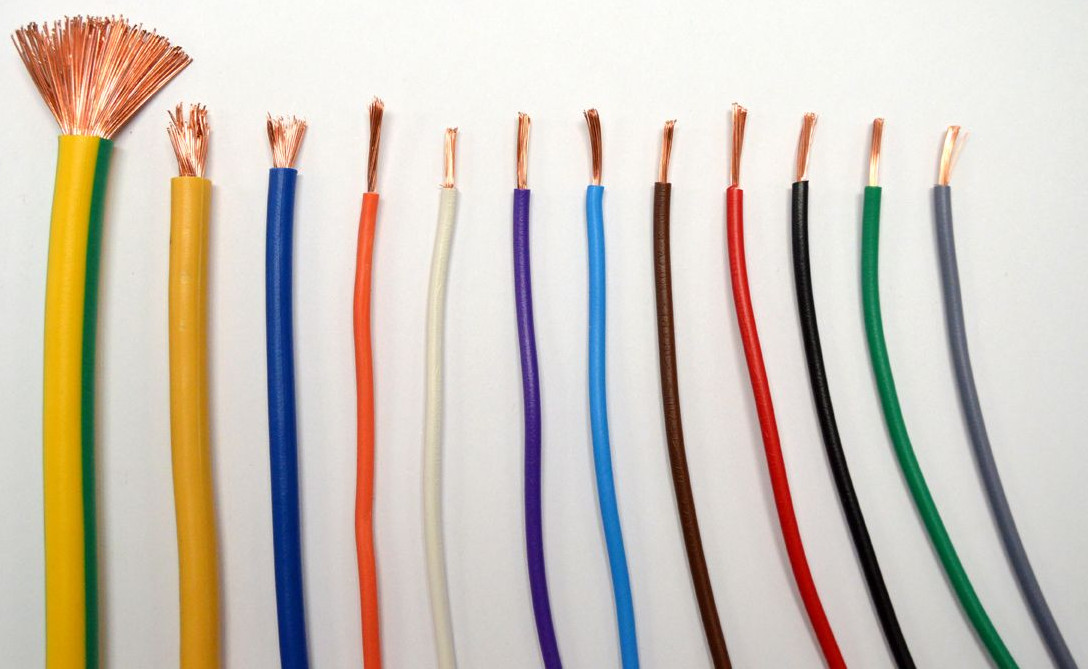Technical installation of indoor and outdoor electricity and lines for small hydroelectricity
In order to limit electrical accidents, people should pay attention to the basic regulations on installation of domestic electricity and some measures to ensure safety when operating and using electricity.

Electrical installation techniques in the home
1. Electric wires in the house must not use bare conductors but must use good quality insulated conductors . The size (section) of the conductor is chosen so that it is able to load the current to the power tools it provides, not to use small cross-section wires to power tools with too large a capacity to avoid. causing fire to the house. Electricity users can refer to the table in Appendix 1 to estimate the current consumption of electrical appliances in the home and table 2 to select the standard electrical wire size.
2. Installation of indoor wiring usually placed on clamping porcelain, ceramic pulley or threaded protection tube, this tube is usually made of plastic.
3. The distance between two clamping porcelain or 2 adjacent porcelain pulleys should not be too large, ensuring that the distance between the conductor and the architectural object (wall, ceiling .) is not less than 10mm.

4. When connecting the power cord, it must be staggered and have an insulation tape wrapped outside the joint (especially double wires). If installing underground wiring in the wall, the wire should not have a connection and must be wrapped with 2 layers of good insulation.
5. Electric conductors penetrate walls, roofs must be placed in protective porcelain pipes. Do not allow rain water to collect in the tube or flow into the tube into the house.
The distance from insulators to the head of the electrical wire to the house must not be less than 2m.
6. Electric breaker, electrical switch must be placed in an easy operation position, the bottom should not be entangled, the place must be spacious and bright enough, ensuring that when it is necessary to close and cut the power quickly and promptly time
7. Electric circuit breakers, electrical switches are often installed on small wooden boards, and are fastened to walls or pillars, the most reasonable position to mount a wooden board is about 1.5 meters from the ground.
Electric breakers, electrical switches must have a safety cover. The cover has the effect of preventing electric accidents when we accidentally bump into and avoid the electric arc beam discharging when closing or cutting the power.
8. The main indoor line and each sub-line as well as every household electrical appliance must have a fuse- type protection fuse .
The fuse wire of the protection fuse must be in accordance with the guaranteed use when there is an electric shock (remember that the wire does not have to protect people from electric shock).
The wire must be installed according to the prescribed standards, for example in a single-phase circuit (1 heater wire and 1 cold wire), it is compulsory to place the fuse on the heating wire.
If both wires are hot wires (2 phase wires), it is compulsory to place fuses on both wires.
9. In humid places, especially in bathrooms, do not place electrical outlets, electrical switches, do not pull wires through this place. For the washing bathroom, the more secure place to place the electrical switch is outside the door of the room, adjacent to the hinged side door frame.

10. If the circuit breakers, switches, and electrical outlets are damaged, they must be replaced immediately, because if not, people are very likely to touch conductive parts.
11. Need to explain and educate children to understand and not to insert metal wires, iron nails or insert their fingers into an electrical outlet.
12. Never close, cut the switch, switch . when the hand is still wet because the water in the hand can flow into the electrical parts in the circuit breaker, switch and will transmit electricity to the person who is electrocuted .
13. Absolutely do not use your fingers to test whether there is electricity or not, but use a low voltage test pen or leave the light bulb to determine. When the hands and feet are wet, barefoot is not allowed to plug or unplug the electric wire to replace the fuse wire, to close the circuit breaker .
14. When the electricity in the house is broken, if the damaged part is located above the galvanometer, it must notify the electricity branch to send workers to repair, absolutely not to call non-electric workers outside the electricity industry. If the broken part behind the galvanometer is required to cut the main circuit breaker and then repair the fault.
15. Only use electrical equipment and electrical equipment that have been grounded, connected without safety protection.
15.1 . Earthing protection , effect:
- Protective earthing is using electrical wire connecting the metal shell of electrical equipment when normally there is no electricity with iron and steel grounding device buried underground.
- Protective earthing is applied in a three-phase network with neutral logic, which makes the current when the shell touches - because the insulation is broken (short-circuited short-circuiting), which will be transmitted to the ground by connecting wires. device shell with grounding object.When touching such device's shell, the human body will be considered to be parallel to the grounding device with very small resistors, thus reducing the amount of current flowing through the body, so it is no longer dangerous.
15.2. Unprotected connector , effect:
- Unprotected connection is to use electrical wires connecting the metal shell of electrical equipment when there is normally no electricity with neutral wire grounded by the grid.
- Non-protective connector applied in 3-phase 4-wire network, when an electrical current touches the device's shell, will create a short-phase short-circuit current that breaks the fuse or makes the switch automatically disconnect the power in the circuit of the electrical network or damaged device with the smallest short-circuit time.In order to ensure continuous protection even in the case of a neutral wire breaking, it is necessary to perform grounding several times (repeating) and necessarily ground at the end of the grid.
Appendix 1: Current consumption of commonly used tools
TT
Name electrical appliances and capacity
Electric
Type 120V
220V type
first
Iron (iron): Large type 800W
6.7A
3.6A
Small type 300W
2.5A
1.4A
2
Electric cooker: Large type 1.500W
12.5A
6.8A
Medium type 1,000W
8.4A
4.6A
Small type 300W
2.5A
1.4A
3
Electric rice cooker: Type 600W
5A
3A
4
Hair dryer: Type 300W
2.5A
1.4A
5
Ball light with heart: Type 100W
1A
0.5A
Type 75W
0,7A
0.4A
Type 60W
0.5A
0.3A
6
Tube light: Type 1.2m - 40W
1A
0.5A
Type 0.6m - 20W
0.5A
0.3A
Type 0.3m - 10W
0.2A
0.1A
7
Electric fan: Large type 300W
3.1A
1.7A
Small type 100W
1A
0.6A
8
Refrigerator: Large type 300W
3.1A
1.7A
Small type 100W
1A
0.6A
9
Television: Type 120W
1.3A
0,7A
Appendix 2: PVC-coated copper conductor
A - Hard wire placed in protective tube
TT
Name of wire size
Number of fibers and diameter of each fiber (mm)
Section (mm 2 )
Maximum load current (A)
first
Wire 8/10
1 0.8 fiber
0.5
4
10/10
1 fiber 1.0
0.79
6.5
October 12
1 fiber 1,2
1.13
9
October 16
1 strand 1.6
2.01
13.5
October 20
1 fiber 2.0
3.14
18
October 26
1 fiber 2.6
5.31
25
2
Cable
3.5
7 fibers 0.8
3.52
19
5.5
7 fibers 1.0
5.50
26
8
7 strands 1,2
7.92
33
14
7 strands 1.6
14.07
forty six
B-Soft wire in parallel
TT
Name of wire size
Number of fibers and diameter of each fiber (mm)
Section (mm 2 )
Maximum load current (A)
first
October 7
12 fibers 0.20
0.38
6
2
0.5 or 8/10
16 fibers 0.2
0.50
8
25 fibers 0.16
0.50
8
3
0.75 or 10/10
24 fibers 0.20
0.75
ten
30 fibers 0.18
0.76
ten
37 fibers 0.16
0.74
ten
4
1.0 or 12/10
22 fibers 0.20
1.01
twelfth
40 fibers 0.18
1.02
twelfth
50 fibers 0.16
1.01
twelfth
5
1.50
99 fibers 0.20
1.54
16
- Japan: The indoor farm is 100 times more productive than the field
- 7 simple ways to reduce air pollution in your home
- The image of electrician EVN cleaning the power line with high pressure water
- Interesting animations on product production lines
- 'Discover healthy indoor plants
- Time to turn the car into an oven when parking in the sun
- Draw lines for robbers
- Indoor pollution is the most deadly
- Discover solutions to purify indoor air with ... microalgae
- Why are power transmission lines and electric pylons not short-circuited when it rains?
- Strange lines of striped clouds in Australia's sky
- Outdoor radiation in Fukushima reached a record
 'Barefoot engineer' invents a pipeless pump
'Barefoot engineer' invents a pipeless pump Process of handling dead pigs due to disease
Process of handling dead pigs due to disease Radiometer
Radiometer Warp Engine: Technology brings us closer to the speed of light
Warp Engine: Technology brings us closer to the speed of light Why should we use energy saving?
Why should we use energy saving?  He developed a bracelet that recognizes user emotions
He developed a bracelet that recognizes user emotions  Power saving with smart software manufactured by students
Power saving with smart software manufactured by students  6 mistakes when using electrical appliances can make you pay for your life
6 mistakes when using electrical appliances can make you pay for your life  Preventing accidents when using electrical equipment during the rainy season
Preventing accidents when using electrical equipment during the rainy season  What will happen if the electric click on the brain dies?
What will happen if the electric click on the brain dies? 